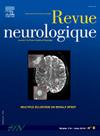Homozygous DNAJB4 deletion revealing myopathy with acute respiratory failure
IF 2.3
4区 医学
Q2 CLINICAL NEUROLOGY
引用次数: 0
Abstract
Homozygous mutations in the DNAJB4 (NM_007034) gene impair HSP40 function, leading to early respiratory failure due to diaphragm involvement and rigid-spine-like characteristics. We describe the case of a 23-year-old male patient who was admitted for acute respiratory failure and motor deficit of the distal upper limbs. Creatine kinase values were elevated (10x upper normal limit), while the pulmonary function tests showed restrictive respiratory syndrome (forced vital capacity at 20% of theoretical values). The deltoid muscle biopsy findings were consistent with myofibrillar myopathy. Genetic analysis by NGS panel sequencing identified a homozygous deletion c.(?_1)_(1014_?)del, p.? (HGVS nomenclature) of the entire DNAJB4 gene, confirmed by qPCR. Both healthy parents exhibited the variant at the heterozygous state. Our results demonstrate that homozygous c.(?1)(1014_?)del, p.? deletion in DNAJB4 leads to a hereditary myopathy, further underscoring the gene's crucial role in muscle maintenance and function.
纯合子DNAJB4缺失显示肌病伴急性呼吸衰竭。
DNAJB4 (NM_007034)基因的纯合突变损害HSP40功能,导致膈肌受累和脊柱样僵硬特征导致早期呼吸衰竭。我们描述了一个23岁的男性病人谁是入院急性呼吸衰竭和上肢远端运动缺陷。肌酸激酶值升高(正常上限的10倍),而肺功能检查显示限制性呼吸综合征(强迫肺活量为理论值的20%)。三角肌活检结果与肌原纤维肌病一致。遗传分析通过NGS面板测序鉴定出一个纯合缺失c.(?_1)_(1014 ?)del, p.?(HGVS命名法),经qPCR证实。在杂合状态下,健康父母均表现出该变异。我们的结果表明纯合c.(1)(1014_?)del, p.?DNAJB4缺失导致遗传性肌病,进一步强调了该基因在肌肉维持和功能中的关键作用。
本文章由计算机程序翻译,如有差异,请以英文原文为准。
求助全文
约1分钟内获得全文
求助全文
来源期刊

Revue neurologique
医学-临床神经学
CiteScore
4.80
自引率
0.00%
发文量
598
审稿时长
55 days
期刊介绍:
The first issue of the Revue Neurologique, featuring an original article by Jean-Martin Charcot, was published on February 28th, 1893. Six years later, the French Society of Neurology (SFN) adopted this journal as its official publication in the year of its foundation, 1899.
The Revue Neurologique was published throughout the 20th century without interruption and is indexed in all international databases (including Current Contents, Pubmed, Scopus). Ten annual issues provide original peer-reviewed clinical and research articles, and review articles giving up-to-date insights in all areas of neurology. The Revue Neurologique also publishes guidelines and recommendations.
The Revue Neurologique publishes original articles, brief reports, general reviews, editorials, and letters to the editor as well as correspondence concerning articles previously published in the journal in the correspondence column.
 求助内容:
求助内容: 应助结果提醒方式:
应助结果提醒方式:


